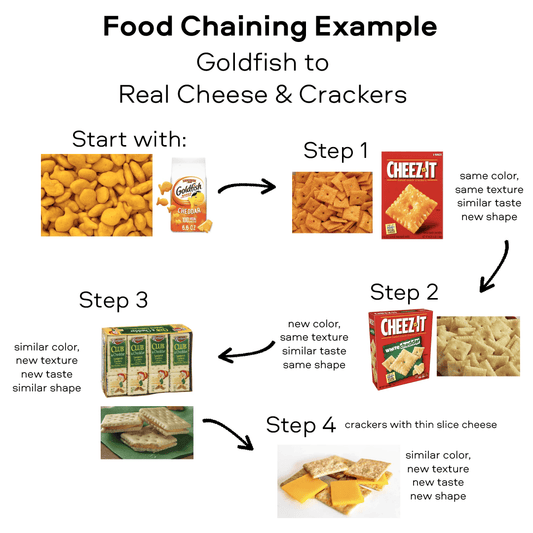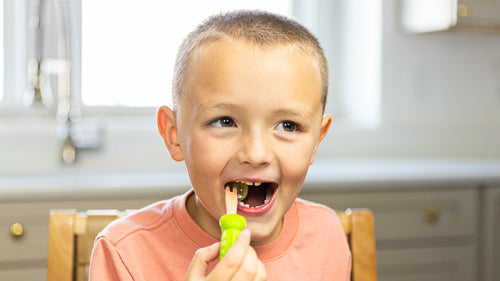In this post, you'll learn what food chaining is and how it can help your picky or fussy eaters add variety to their diets. We'll also give you food chaining examples!
Here’s what you’ll learn:
We're The Picky Eating Experts
I’m Ellie, a Pediatric Dietitian and picky eater expert. For nearly a decade i've helped picky eaters and their parents.
I love it when kids are able to relax and explore during mealtimes.
It’s why I created my original products on Dabbldoo.com that help picky eaters (or any kids!) interact with and try new foods.
After reading this blog post, go over and check out our feeding utensils that make picking up food so much more fun they encourage kids to try foods they normally won’t!

Food Chaining: The Basic Idea
Food chaining is one of the most effective strategies to use to help your child learn to eat and enjoy a variety of new foods.
In fact, this is probably the most common strategy used in expensive feeding therapy sessions!
As a pediatric dietitian, I’ve helped many children add variety to their diets.
I’m going to walk you through the proper steps so you can help your children add more variety to their diets too.
Helping a picky eater branch out to new foods can seem like a daunting task, especially if they currently have a very limited diet.
If you’re serious about helping your picky eater branch out to new foods, you need to learn about food chaining.
Food chaining is one of the most recommended feeding strategies for picky eaters, fussy eaters, problem eaters, and anything in between.

Why does food chaining work?
Many feeding professionals that work with fussy eaters, picky eaters, and selective eaters prefer to use food chaining for a few different reasons.
We know by professional experience and through research that using force, bribery, and pressure tactics don’t actually help children eat better, learn to like new foods, or develop healthy eating patterns long term.
Helping your child reach the point that they decide to try a new food on their own is what leads to success.
With food chaining, instead of emphasizing eating foods they “don’t like” (yet) or that they aren’t comfortable with trying, you are emphasizing foods they may like because it has similar traits to their favorite foods.
Think about it this way, if someone put a completely new food in front of you and didn’t tell you anything about what it would taste like, feel like, etc. would you be willing to eat a whole serving of it?
For most of us, probably not.
But, if someone put a new food in front of you and said “this tastes creamy like Alfredo sauce” you may be more likely to try it knowing what to expect and knowing you already like Alfredo sauce.
Food chaining works the same way.
It helps your child make connections between foods they currently enjoy and new foods they have yet to explore yet.
It’s a natural way to help them become more open minded to trying new foods.
Instead of pushing their bowl away at first glance, food chaining will also help your kids learn how to deal with new foods they might be served.
What to do if you have a severe picky eater?
There are a few important things to know when you have a severe picky eater.
Before we delve into food chaining, It’s recommended that your child be seen by at least a pediatrician.
Why?
Unfortunately, most pediatricians aren’t trained in all the ins and outs of picky eating and oftentimes, warning signs are overlooked or completely missed.
Sometimes, incorrect advice is also given which makes picky eating worse and can make you feel even more desperate and helpless as a parent of a severe picky eater.
The reality is, there are often numerous factors at play with severe picky eating.
In order to make progress, you’ll need to explore several areas (with the help of appropriate professionals) to determine the root cause(s) of their picky eating related to medical, nutritional, feeding, sensory, and/or behavioral factors.
This could be one or a combination of: occupational therapists, speech language pathologists, behavioral psychologists, pediatricians, or registered dietitian nutritionists.
If there are concerns in one or more of these areas (hint: there always is), you’ll want to get professional help from those who specialize in the area(s) of concern.
Luckily, after you rule out any medical, physiological, or behavioral concerns, food chaining is the next step.
You can use this strategy at home to supplement your feeding therapy plan or start this until you can get further individualized help!
What is food chaining?
Food chaining is actually quite simple. The principle of food chaining is to utilize foods your child currently eats to expand their diet instead of forcing them to eat entirely new foods they aren’t comfortable with yet.
Essentially, it helps your child take baby steps toward accepting new foods.
This has been found to be much more effective long term for improving picky eating.
The food chaining strategy starts with what foods your child currently eats and gradually incorporates new foods that have similar features to their favorite foods (i.e. texture, color, taste, etc).
This will make more sense as you continue reading.

How to start food chaining
If your child is not currently eating any vegetables, and you try to get them to eat - let’s say - broccoli, the chance of them doing that willingly is very, very low.
You would probably have to force them to eat it.
We know that using force or pressure to eat foods is NOT motivating for picky eaters. It actually has the opposite effect and makes them hate that food more.
Using this example, broccoli wouldn’t be a great starting point for food chaining. Let’s look at an example that would be a good starting point using food chaining and take you through the process of how to do it!
Step 1: Create your child’s favorite foods list
The first step when doing food chaining is making a list of all the foods your child currently enjoys eating. The more specific and thorough your list, the better.
Don’t forget condiments/sauces, beverages, and if applicable, specific brands if your child will only eat one brand of that food.
Here is an example list of a child’s accepted foods.
Johnny’s Food List
These are foods that johnny likes eating and typically always accepts:
Goldfish Crackers - Orange
Veggie Straws
Pirate Booty
Saltine Crackers
Soft Pretzel Bites
Dino Nuggets
French Toast Sticks (Walmart Brand)
Ham & Cheese Hot Pockets
Pancakes (blueberry, plain, chocolate chip)
Waffles (plain homemade, Eggo brand)
Raspberry
Strawberry
Apples
Banana
Cucumbers
White Milk
Chocolate Milk
Soda (all varieties)
Smoothie (pink berry smoothie)
Step 2: Look for similarities among foods
Now let’s look for trends.
After you’ve made your list, look to see if you can find any common food characteristics through the list related to:
- Food temperature (hot, warm, or cold)
- Texture (crunchy, moist, creamy, crispy, liquid, etc.)
- Color (orange crackers, red fruits, etc.)
- Taste (salty, sweet, savory, etc)
Using the example list above, there are several salty, crunchy snacks listed (Goldfish crackers, Pirate Booty cheese puffs, and Veggie Straws.)
There are also several cheese flavored snacks.
We could also focus on the color orange since Goldfish and many other cheesy, crunchy snacks are also orange.
Now, let’s think about other snacks that are salty, crunchy, and maybe cheesy to create a food chain.
Step 3: Create your food chain and remember baby steps!
After you determine what food traits your child’s favorite foods have in common, it’s time to formulate a plan to introduce new foods that include those pleasant aspects of your child’s favorite foods - often adding a small change.
In the list above, you’ll notice there are several salty, crunchy snacks on their favorites list.
Remember, food chaining is introducing new foods that have the same flavors and/or features as your child’s favorite foods.
Warning, with new foods, you don’t want to change too much too soon.
This is about taking baby steps toward new foods to help expand your picky eater’s diet and eventually include more healthy, nutrient dense foods.
By taking baby steps, your child will be way more likely to willingly try new foods and learn to enjoy them more quickly. It lowers the barrier of entry to new foods.
Food chaining examples
Here are some real-life food chaining examples for picky eaters, fussy eaters, and selective eaters that I’ve used on clients, and even my own kids!
Here is an example of a possible food chain using the above principles:
Food Chaining Example #1: Focusing on Salty, Crunchy, & orange

This is a food chaining example of how to get from Goldfish to cheese. I've actually done this same food chain for my kids.
Food Chaining Example #2: Focusing on transitioning from cheese crackers, to real cheese.

This is an example of how to get from Goldfish crackers to real cheese.
Want more practical food chaining examples? Check out this post for a free printable of food chaining examples.
Step 4: Execute your food chaining plan
It’s easy to forget not to pressure when you really want your child to make a step up the chain.
Also, it’s really important to start small.
Start with small bite sized items like a half a cracker or a slice of banana rather than several crackers or an entire banana.
We don’t want them to be overwhelmed with too much “new.”
It’s ok to talk about texture and give them context. “This will feel crunchy” or “This is soft and squishy like a raspberry.”
It’s also ok to model or demonstrate playing with or eating the food, but remember that your child needs to be in control. They feed themselves.
If you are patient and follow the above process, overtime your child will learn to willingly accept and enjoy new foods.
Whether your picky eater is in feeding therapy or just working with you at home, you’ll be able to track and see their progress as things improve.

Food chaining rules for picky eaters
Here’s a few points to keep in mind:
- Do not pressure your child to eat. Don’t say things like “you need to eat” or “just try a bite.”
- Be patient. Remember that trying new foods involves all the senses. Being comfortable looking at the food is a good first step, then touching it such as poking it (even better with our fun food picks), smelling, tasting and finally eating it.
- Don’t do big items or large servings all at once. Start small and work up to larger items or bigger portions. Example: Cut the broccoli piece down if it’s large or offer just a small portion of noodles, not an entire bowl full.
- Do not feed your child. Let them self feed. Once you serve them their food, it’s up to them to feed themselves.

Bottom line: Picky eating can’t be fixed overnight, and there is not one magical way to make it go away. But, food chaining is a great way to help improve your child’s picky eating habits and develops skills necessary to overcome picky eating as they grow up and encounter new foods throughout their life.



